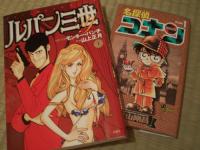 When I last wrote that entry on the many shortcomings of Japanese mangas, my original intent truly was to follow it up shortly with my own recommendations, or at least observations, as a skeptical, yet sincere newcomer to the genre…
When I last wrote that entry on the many shortcomings of Japanese mangas, my original intent truly was to follow it up shortly with my own recommendations, or at least observations, as a skeptical, yet sincere newcomer to the genre…
The fact that it took me three months to get to it, is a testament to the sad state of affairs of this industry (and my own sorry ass’ inability to get anything done when not threatened at gunpoint). Actually, the decision to start reading mangas is an old one, one that arose around the time I woke up one day and realized I could suddenly understand Japanese (すっげぇ〜!日本語を喋れるよ!さああ、僕は貝が好きなの・・・). Well, alright: understand might be pushing it a bit, but I’ve been known to conduct reasonably flawless weather-related conversations with my neighbours: a major improvement from my arrival on Japanese soil, where my vocabulary was essentially limited to three Japanese words, one of which I cannot repeat on this site unless you can testify you are over 18 and click here.
Thing is: drunken conversation with Samurai friends did and still does wonders to my verbal skills, I can pull off a semi-decent everyday-Japanese provided it stays on the topic of whose turn it is to pay the next round, or monosyllabic expressions of my appreciation for miscellaneous types of music or other artistic works. Anything slightly off the beaten path usually gets me nodding complacently until I somehow manage to catch a few words that could clue me in on whatever it is we are talking about. Similarly, that whole level-of-speech issue has not been getting any better: you know things are bad when your friend – who has just chugged half a gallon of rum directly off the bottle – kindly worries about your use of excessively colloquial expressions.
Horizons have to be widened and grammar needs improving dramatically.
Hence: Mangas
First, because books are convenient: you can study them anytime, anywhere and by yourself; they do not require a language exchange partner who will be either convinced you are hitting on her, or actually hitting on you (and yea, the feminine form here has a purpose: just check the number of candidates for language exchange in English or French out there and their repartition by gender).
Also because, taking my cue on the local upcoming generations, I cannot read kanjis for shit. Which rules out most magazines and daily newspapers. Some magazines are not that hard – possibly even below my level – but there are only so many times you can read about the latest news on panty thieving activities, detailed voyeuristic recounts of schoolgirl groping-related arrests or nampa tips, straight from the pros (the gist of which can usually be found in all its quaint alliteration-riddled English translation glory on the Mainichi’s website).
As for regular books, real literature, eternal classics of the Japanese masters: try opening an original Mishima volume for laughs, just once. I swear, that guy uses kanjis even my dictionary has never heard of.
Mangas, on the other hand, rarely make use of overly elaborate kanjis, yet can cover a wide array of situations and lexical fields, all along offering saucerplate-eyed visual clues of the ongoing story. Additionally, most have furiganas for part or all of the kanjis used (depending on the target age for the series).
Let’s stop here for a slightly tedious digression that you may want to skip if you know anything about the Japanese language and the black magic art known as reading it:
As you may know, Japanese is written using both kanjis (roughly 1000 to 2000 different ones for basic books and newspapers) and two syllabaries known as kanas. A syllabary is similar to an alphabet, in that each character represents a sound, but unlike, say, the latin alphabet, Japanese kanas each match a full sound (“ma”, “mi”, “mu”, “mo”, “ra”, “ri”, “ro” etc). Each syllabary contains 80-some characters and is usually the first thing anybody will learn when studying Japanese.
In theory, every Japanese word could be spelled using only kanas (and thus easily readable by anybody with reading abilities above kindergarten level). This is quite convenient in cases like computer interfaces, where words are typed using kanas, before being turned into kanjis through some menu selection or such. In practice, though, most people (yours truly, included) will find it incredibly tedious to read a text written entirely using phonetic kanas (remember that Japanese doesn’t separate words either). For texts meant to be readable by kids or sufficiently important not to take a chance with the odd illiterate countryman, a compromise is found by writing both the kanji and its kana spelling alongside. These kanas are usually written in a smaller font above (when writing horizontally) or to the right (when writing vertically) of the kanjis they explain. They are called furiganas and will make the most arcane reading accessible to the casual reader.
One important reason to love furiganas, especially for foreigners, is that if you encounter a kanji you are unfamiliar with, you will probably want to look it up in a dictionary… Which is infinitely easier to do if you actually know how to pronounce it.
It is still possible to look up both meaning and reading of an unknown kanji by using a method known as “multiradical lookup”, relying on the number of strokes and a few recognizable components of the whole ideogram. Even if with a bit of habit and the right tools, multiradical searches can be done fairly fast, they are considerably more annoying to conduct than regular phonetic lookups.
End of digression